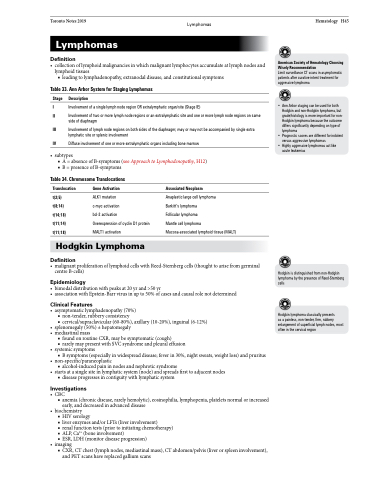Page 585 - TNFlipTest
P. 585
Toronto Notes 2019 Lymphomas Lymphomas
Definition
• collectionoflymphoidmalignanciesinwhichmalignantlymphocytesaccumulateatlymphnodesand lymphoid tissues
■ leadingtolymphadenopathy,extranodaldisease,andconstitutionalsymptoms
Table 33. Ann Arbor System for Staging Lymphomas
Stage Description
I Involvement of a single lymph node region OR extralymphatic organ/site (Stage IE)
II Involvement of two or more lymph node regions or an extralymphatic site and one or more lymph node regions on same
side of diaphragm
III Involvement of lymph node regions on both sides of the diaphragm; may or may not be accompanied by single extra lymphatic site or splenic involvement
IV Diffuse involvement of one or more extralymphatic organs including bone marrow
• subtypes
■ A = absence of B-symptoms (see Approach to Lymphadenopathy, H12) ■ B = presence of B-symptoms
Hematology H45
American Society of Hematology Choosing Wisely Recommendation
Limit surveillance CT scans in asymptomatic patientsaftercurative-intenttreatmentfor aggressive lymphoma
• Ann Arbor staging can be used for both Hodgkin and non-Hodgkin lymphoma, but grade/histology is more important for non- Hodgkin lymphoma because the outcome differs significantly depending on type of lymphoma
• Prognostic scores are different for indolent versus aggressive lymphomas
• Highly aggressive lymphomas act like acute leukemias
Table 34. Chromosome Translocations
Translocation
t(2;5) t(8;14) t(14;18) t(11;14) t(11;18)
Gene Activation
ALK1 mutation
c-myc activation
bcl-2 activation
Overexpression of cyclin D1 protein MALT1 activation
Associated Neoplasm
Anaplastic large cell lymphoma
Burkitt’s lymphoma
Follicular lymphoma
Mantle cell lymphoma
Mucosa-associated lymphoid tissue (MALT)
Hodgkin Lymphoma
Definition
• malignantproliferationoflymphoidcellswithReed-Sternbergcells(thoughttoarisefromgerminal centre B-cells)
Epidemiology
• bimodaldistributionwithpeaksat20yrand>50yr
• associationwithEpstein-Barrvirusinupto50%ofcasesandcausalrolenotdetermined
Clinical Features
• asymptomaticlymphadenopathy(70%)
■ non-tender, rubbery consistency
■ cervical/supraclavicular (60-80%), axillary (10-20%), inguinal (6-12%)
• splenomegaly(50%)±hepatomegaly • mediastinalmass
■ found on routine CXR, may be symptomatic (cough)
■ rarely may present with SVC syndrome and pleural effusion • systemicsymptoms
■ B symptoms (especially in widespread disease; fever in 30%, night sweats, weight loss) and pruritus • non-specific/paraneoplastic
■ alcohol-induced pain in nodes and nephrotic syndrome
• startsatasinglesiteinlymphaticsystem(node)andspreadsfirsttoadjacentnodes
■ disease progresses in contiguity with lymphatic system
Investigations
• CBC
■ anemia (chronic disease, rarely hemolytic), eosinophilia, lymphopenia, platelets normal or increased
early, and decreased in advanced disease • biochemistry
■ HIVserology
■ liver enzymes and/or LFTs (liver involvement)
■ renal function tests (prior to initiating chemotherapy) ■ ALP, Ca2+ (bone involvement)
■ ESR, LDH (monitor disease progression)
• imaging
■ CXR, CT chest (lymph nodes, mediastinal mass), CT abdomen/pelvis (liver or spleen involvement),
Hodgkin is distinguished from non-Hodgkin lymphoma by the presence of Reed-Sternberg cells
Hodgkin lymphoma classically presents
as a painless, non-tender, firm, rubbery enlargement of superficial lymph nodes, most often in the cervical region
and PET scans have replaced gallium scans


